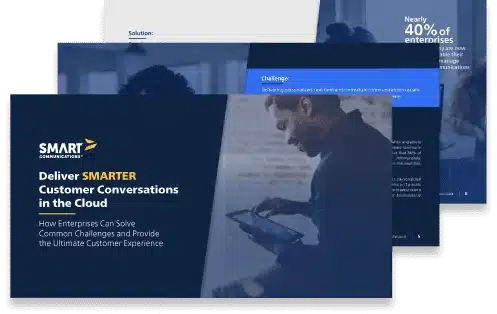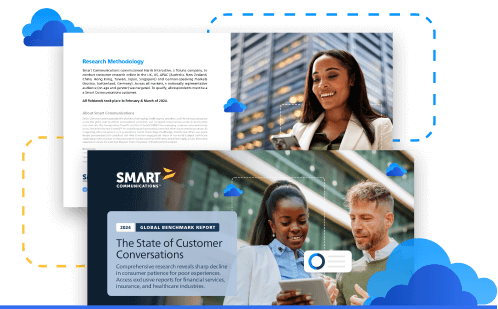How to Accelerate Policy Onboarding and Renewals in Auto Insurance
By Karen Oakland, Senior Marketing Director, North America at Smart Communications
Changing U.S. state regulations around Personal Injury Protection (PIP) add-ons for auto insurance offer a great example where digital forms transformation can have a big impact. Insurers often need to adapt to regulatory changes quickly, and that means updating often a huge library of forms, processes and policy documents to stay in compliance.
As you shift your business to digital, that should mean more than simply moving paper forms online. Customers and agents still detest the tedious nature of searching and downloading the right form, printing it, completing information you already know about them, then going back and forth to complete and approve the new policy or renewal.
In contrast, next-gen forms technology enables insurers to respond to changing regulations quickly while delivering a better, faster customer experience. This post discusses how next-gen forms can help car insurance carriers gain operational efficiency, improve top-line revenue and provide a frictionless customer experience around new policy underwriting, renewals, and service.
PIP Insurance Regulations: Keeping Up with Change
What is PIP? The PIP component of auto insurance covers medical expenses, regardless of who’s at fault, and often includes lost wages. It’s mandatory or optional in 22 U.S. states. Depending on that state, PIP may be an available option or a required policy add-on, and rules continuously evolve based on state budgets and the ongoing discourse between the legal community, insurers, healthcare providers and state legislators.
Michigan is a prime example of where insurers need to respond rapidly to regulatory change, with new PIP rules set to take effect in 2020. Currently, Michigan’s seven million drivers must purchase unlimited PIP coverage as part of their auto policy, guaranteeing that insurance companies will cover all medical costs associated with car accident injuries – no matter who is at fault.
Yet starting after July 1, 2020, Michigan auto insurers will need to give customers the option to select from five different coverage tiers, many of which would lower customers’ rates, but also limit their coverage. There’s even a tier for 100 percent opt-out, with Medicaid picking up the coverage.
So that means if you operate in Michigan, you need to change and update all of your forms for PIP sales and renewals. You will also need to re-engineer processes around policy renewals. That can become a mountain of work if you’re reliant on paper, PDFs or hard-coded Java-based electronic forms.
Your Competitors Are Honing Their Digital Customer Experience
According to the insurance research firm Novarica, “Carriers are pushing the envelope in digital self-service, designing products for digital processes and targeting digitally oriented consumers. Generational cohorts like Millennials and Gen Z expect digital experiences.”
The point is: to keep pace and remain relevant, you need to be able to capture customer information digitally and then create quotes on-demand, tailored to individual state requirements – with or without PIP. Then, as regulations change, you need renewal communications to accurately and seamlessly update across your online venues.
Fix Your Forms Library with Adaptive Forms
Many insurers still publish a huge library of static, blank PDF forms online and try to call that “digital.” This forces the customer or agent to deal with identifying and downloading the right PDF, filling it out by hand, and then scanning or faxing it back to the company. That’s a terrible experience! It also creates operations problems, like how to do the following:
- Make rapid forms and rules changes
- Ensure customers/agents have the most updated form
- Update and check every form for every state
- Eliminate issues caused by NIGO (not in good order) forms
- Resolve typical data errors inherent with OCR tools
Here’s how to solve the problem:
Rather than applying costly resources to continuously modify forms, you need to engage consumers in an online discussion, leading them to select the ideal coverage for their needs. With Intelledox, you can engage modern consumers and communicate about your PIP offerings the way they like best.
Next-gen forms take the concept of “smart” online forms to a new level. These discussions are essentially digital self-service interactions. Customers and agents input what they want and engage with a responsive form that drives them to the right offer based on their expressed needs, including PIP coverage.
These interviews are accurate and engaging because they are holistic by doing these things:
- Establish rules for how each form field/question appears
- Automate workflows to support exception handling
- Pre-populate form fields with customer-specific data already located in your system of record
- Interact with users via Q&A that is state-specific and situation-specific
As part of the adaptive interview, many of our insurance clients incorporate a workflow to automatically flag urgent issues or exceptions. This enables them (or their agents) to alert a customer in real-time when additional information or action is needed, such as a live, personal phone call.
The Digital PIP Policy Renewal Process Using Intelledox & DocuSign
When you use Intelledox alongside DocuSign, you can dynamically generate and deliver policies and documentation that correspond to an individual’s locations and circumstances, for an end-to-end personalized and paperless experience.
Harking back to the Michigan example, here’s how that process would look for an existing customer of an insurer:
- Customer logs in to the insurer’s web portal, and Guided Forms are automatically set up and branded, awaiting the customer conversation.
- The auto-interview asks what coverage they desire and presents Michigan’s 5 mandated options
- The user’s selection triggers document creation (I.e. proof of medical insurance).
- System auto-populates the required Michigan ACORD form as the document artifact.
- Appropriate disclosures and notices are attached to the resulting forms.
- Confirmation requests auto-send to the customer via DocuSign.
- Insurer’s backend archive receives digitally signed documents automatically.
The insurer and customer can always opt to output this data to the standard ACORD form, just like producing a tax form for recordkeeping after e-filing taxes.
Conclusion
As an insurer, you need to ask yourself the hard questions if you want to stay top-of-mind with the modern consumer. Are you ready to adapt all your forms as rules and regulations change? Do customers interact with you in digital and mobile-friendly ways for a new policy and renewal processes?
Gone are the days of presenting PIP consumers with a blank form. Instead, greet visitors with a simple question – “What do you want to do?”
The rest happens automatically with your next-gen, guided forms. For more detail about streamlining your auto policy underwriting, onboarding and renewal processes, download our recent whitepaper.



